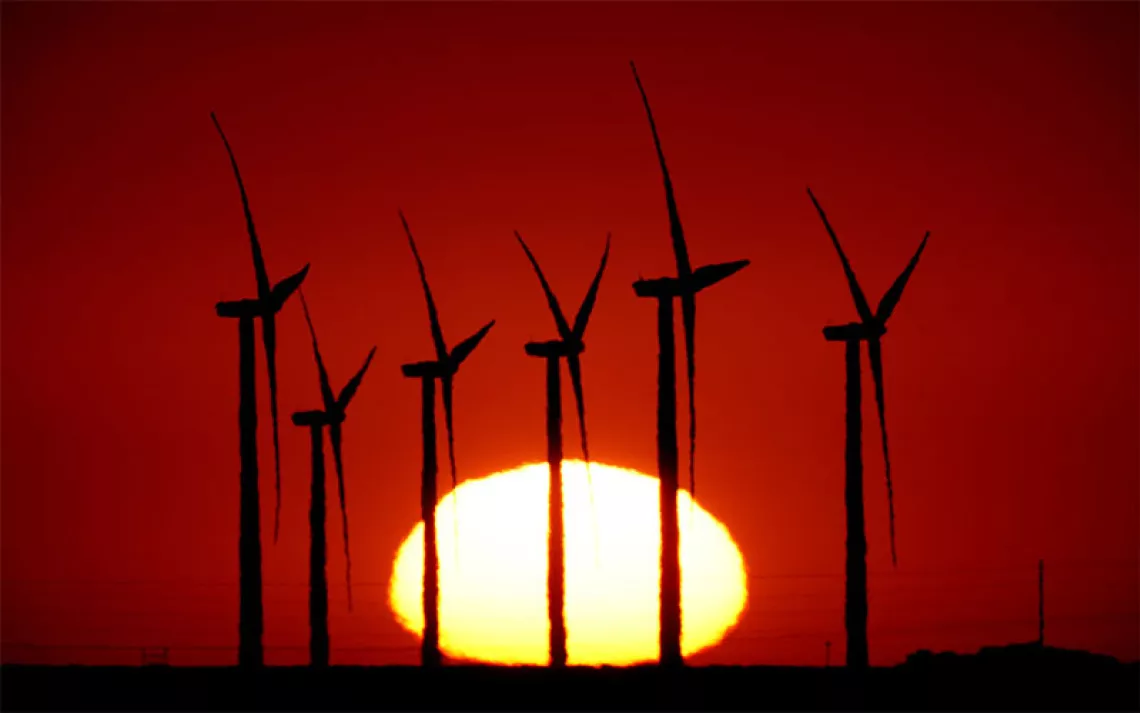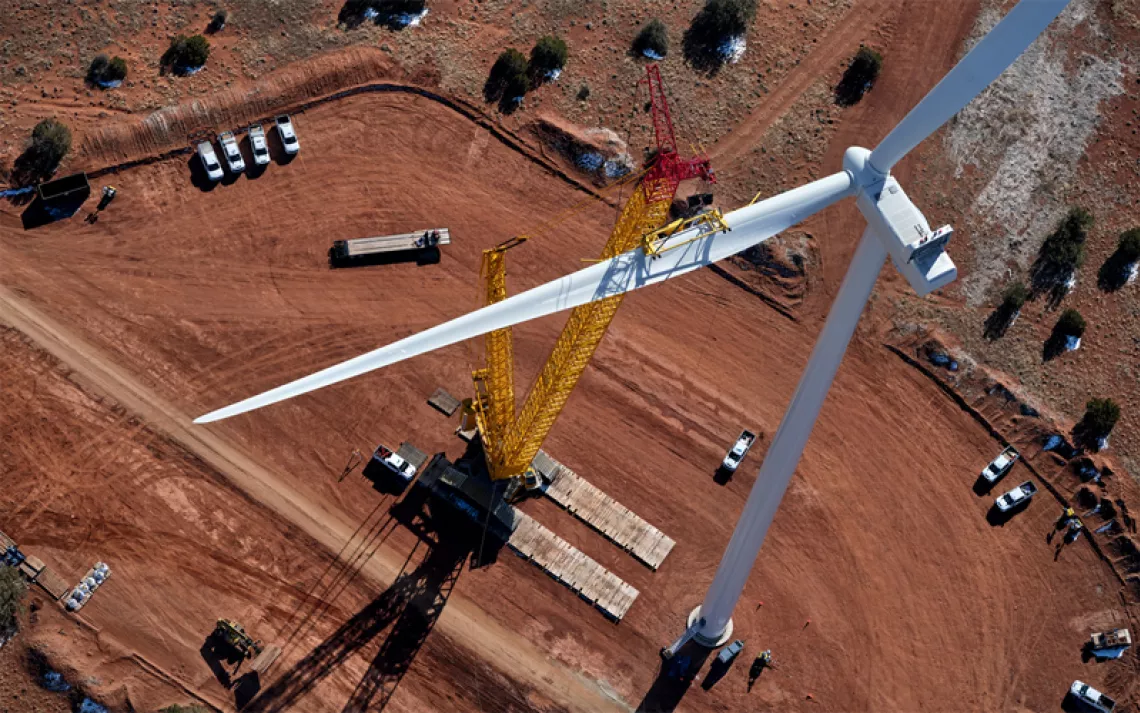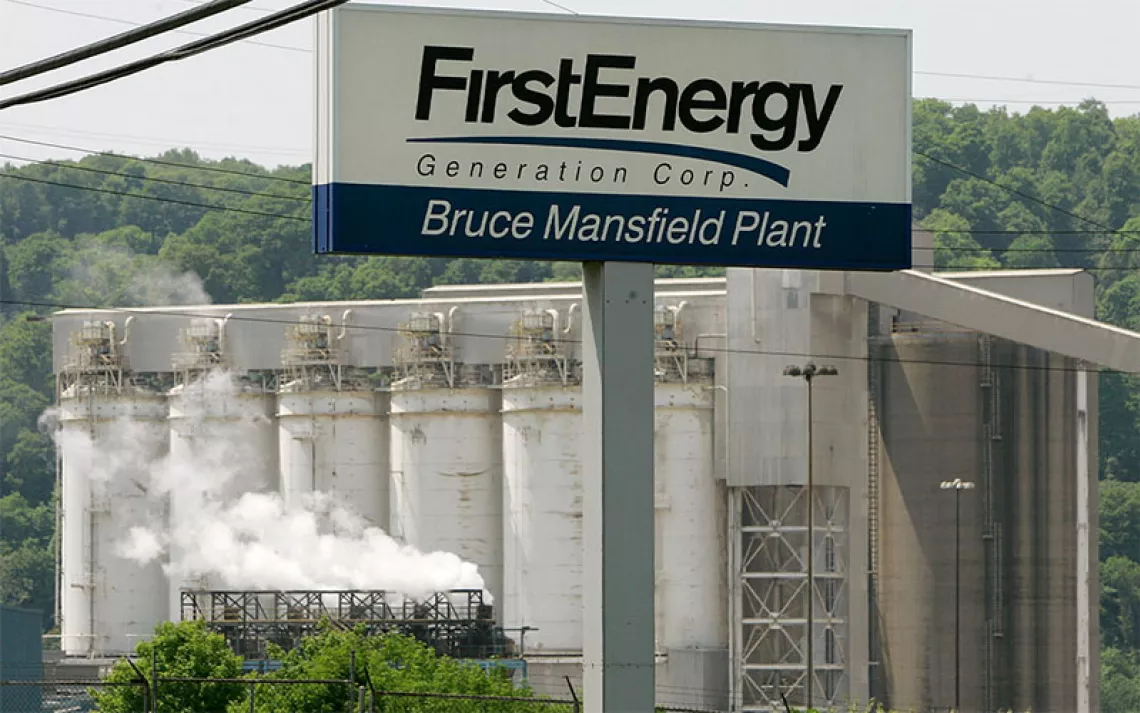The 100% Club
While Congress dithers, corporate America embraces renewable energy
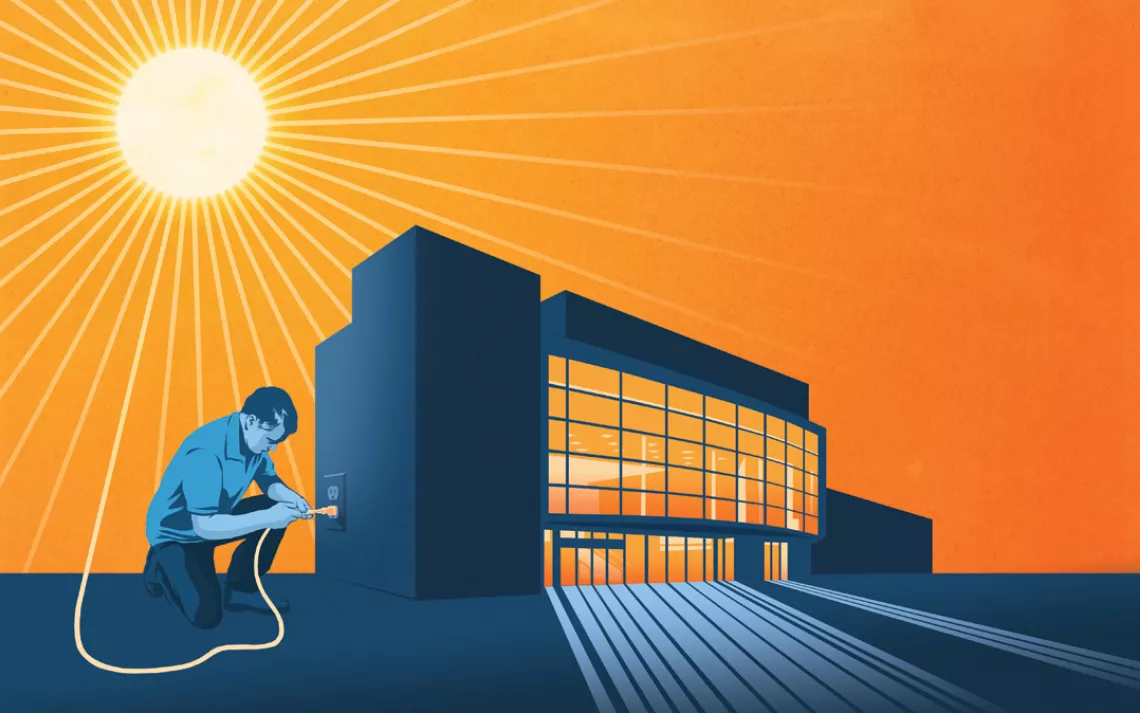
Illustration by Rob Dobi
Steve Howard, a 49-year-old Brit, has devoted most of his career to fighting climate change. He spent seven years as CEO of the Climate Group, a global nonprofit whose goal is "a prosperous, low-carbon future for all." He sounds the part: "There is no peak sun, there is no peak wind," he declares. "We struck sun and we struck wind before we struck oil."
These days, Howard pursues his climate activism as chief sustainability officer of the IKEA Group, the world's largest furniture retailer. IKEA has invested $2 billion in wind and solar power to meet its goal of producing as much renewable energy as it consumes by 2020. "We clearly see them as our future sources of energy," he says.
IKEA is just one of dozens of big companies that are making significant investments in clean energy. In fact, a majority of Fortune 100 companies have invested in solar or wind power or have pledged to reduce their greenhouse gas emissions, or both, according to Power Forward 2014: Why the World's Largest Companies Are Investing in Renewable Energy, a report from the sustainability advocacy group Ceres. They are doing so because they believe it makes good business sense: The costs of solar and wind are falling, state and federal governments offer generous subsidies, and fossil fuel prices can be volatile. Some see green energy commitments as a way to burnish their reputations. Still others are responding to carbon regulation--Europe, California, nine northeastern states, and British Columbia all tax or cap greenhouse gas emissions, and some business leaders believe that many other governments will, and should, follow suit. Whatever the reasons, these companies are signaling that they accept the reality of climate change and proving that renewable energy is neither a job killer nor a drag on economic growth.
Last September, insurer Swiss Re, British telecommunications group BT, clothing giant H&M, food companies Mars and Nestle, and Dutch-based lighting, health care, and electronics firm Philips promised to switch to 100 percent renewable power by 2020 and launched an initiative to encourage other big companies to follow. That milestone has already been achieved by more than a dozen, including Kohl's, Whole Foods Market, Staples, TD Bank, Herman Miller, REI, and the Philadelphia Phillies, according to the EPA's 100% Green Power Users list. Other well-known companies--including Microsoft, Google, Apple, Starbucks, Lockheed Martin, Cisco, and Facebook--have not reached the 100 percent goal, but are nevertheless enormous consumers of green power.
The Walmart in Caguas, Puerto Rico is one of five Walmart facilities on the island equipped with solar panels. In addtion to Caguas, Walmart added solar to sites in Manati, Baymon and two in Ponce. | Photo Courtesy of Walmart
Controversial among this latter group is Walmart, the nation's fifth largest user of clean energy. The Arkansas-based retailer has installed 105 megawatts of solar photovoltaic power, mostly on the roofs of its stores and distribution centers. That gives the company more solar capacity than 35 states, according to Solar Means Business 2014, a report from the Solar Energy Industries Association. Given Walmart's focus on controlling costs, its rooftop arrays are compelling evidence that solar energy can compete with fossil fuels--at least in parts of the country with favorable policies. Elsewhere, however, Walmart gets nearly all its electricity--96 percent, according to critics, which include the Sierra Club--from utilities that burn coal and natural gas. Despite its large use of solar energy, Walmart's greenhouse gas emissions are actually rising.
The challenge for Walmart and other businesses that want to buy renewable energy is that solar and wind power are affordable and available in some states but expensive and hard to find in others. Weather conditions, state subsidies, and utility regulation all come into play. (More than two-thirds of U.S. solar generating capacity comes from solar-friendly California, Arizona, and New Jersey.) The Department of Energy conservatively ranks solar as more expensive than fossil fuels, and wind as more expensive than natural gas but less than coal or nuclear. Newer estimates from researchers at the investment banking firm Lazard all favor renewable power; they report that even without subsidies, "over the last five years, wind and solar PV [photovoltaic] have become increasingly cost-competitive with conventional generation technologies." What's more, corporate buyers say, the long-term costs of solar and wind power are predictable, unlike the constantly fluctuating prices of coal and natural gas. Once solar panels are installed or wind turbines are built, fuel costs are close to free.
Apple fuel cells: Photo taken on July 22, 2014 shows the methane gas fuel cells at Apple Data Center in Maiden, North Carolina, the United States. Running entirely on renewable energy, the Apple Data Center in Maiden, North Carolina, reduces energy consumption and greenhouse emission. | Photo by Xinhua/Eyevine/Redux
No industrial sector has been more committed to renewable energy than the technology industry. Tech firms tend to be nimble and future-oriented, and they compete aggressively for talent; young employees want to work for companies that contribute to solving big problems like climate change. Google, Apple, Microsoft, and Amazon have invested vast sums--a whopping $1.5 billion in Google's case--to develop renewable projects in the United States and around the world.
Apple has focused on its energy-hungry data centers, all of which are now powered by clean sources, including solar, wind, and geothermal. In Maiden, North Carolina, for example, Apple's data center is powered by a combination of two 20-megawatt solar arrays and fuel cells that run on biogas pumped in from a nearby landfill--this in a state where more than 90 percent of the electricity is generated by nuclear power and fossil fuels. Lisa Jackson, the former EPA head who now leads environmental initiatives at Apple, says on the company website: "Whenever you download a song, update an app, or ask Siri a question, the energy Apple uses is provided by nature."
Google's massive investments in renewable power include utility-scale solar photovoltaic and concentrated-solar power plants in California; wind farms in Iowa, Oregon, North Dakota, and Texas; residential rooftop solar across the United States; and solar projects in Germany and South Africa. The company views these investments as one way to deploy its vast hoard of cash--$60 billion at last count. Rick Needham, who directs the energy and sustainability team at Google, says that such clean energy investments help "diversify our cash, put it into businesses that can earn good returns and that aren't correlated to other investments."
Tech giant Microsoft has signed long-term agreements to buy electricity from wind farms currently under construction in Illinois and Texas, where the company operates data centers. In Cheyenne, Wyoming, Microsoft is building a data center that will be completely independent of the grid and run on energy generated from biogas, a byproduct of a nearby water treatment plant. The company helps fund its renewable energy projects by assessing an internal carbon fee on its business groups based on their output of carbon, primarily through electricity use and air travel.
Companies can take at least three approaches to support clean power. The first, and simplest, is to build, own, lease, or contract to buy electricity from solar panels, wind turbines, or biogas generators on their own sites, and then use the electricity to power their own facilities. Apple does this at its North Carolina data center and TD Bank at a branch in Fort Lauderdale, Florida, that is entirely powered by the 400 panels on its roof, on a drive-through canopy, and in an adjacent field, making it the first net-zero-energy bank in the country. The second approach is to invest in new, utility-scale wind and solar projects, no matter where they are located, as IKEA and Google have done. These projects deliver electricity into the grid, where it is mixed with electricity from other sources and sold by a utility. Finally, companies--including many atop the EPA 100% Green Power Users list--can opt for renewable energy certificates (RECs), which, some people would argue, are less effective at driving change.
RECs are cheap and easy to buy (you can order them online) but hard to explain. They are tradable commodities that represent green electricity's environmental qualities, not the power itself. You can't power a toaster with a REC, but you can use it to prove that--somewhere--you have created or purchased the renewable energy it takes to toast your bagel. Companies buy RECs to support renewable energy projects when green power isn't locally available, and they do provide a flow of income to the owners of wind turbines and solar panels, theoretically enabling them to build more. But RECs can be bought from projects that are years or even decades old; they don't necessarily bring new renewable energy projects to market.
Taken together, these varied corporate commitments should help drive the transition to a low-carbon economy, while also driving down the cost of wind and solar power because of their economies of scale. "If companies say they want renewable energy, people will line up to give it to them," says Andrew Winston, a consultant and author who is on the steering committee of RE100, a campaign to get big companies to go 100 percent renewable.
But don't expect corporations, by themselves, to buy enough clean energy to solve the climate crisis. Here's a rough but sobering gauge of corporate impact: The 1,300 companies and nonprofits that have joined the EPA's Green Power Partnership, a voluntary program to promote clean energy, collectively use 28 billion kilowatt-hours of green power annually. That sounds like a lot, and it is--but total U.S. electricity consumption is 3.832 trillion kWh.
This is why environmental groups, including the Sierra Club, say that government action is still essential to drive major change. That might involve aggressive clean energy mandates, utility reform to remove barriers to rooftop solar and energy storage, and, ideally, a price on carbon. To enact these changes, federal, state, and municipal politicians will need support from business. In California, a coalition of venture capital and technology companies helped defeat a 2010 referendum to repeal A.B. 32, the state's landmark global warming law. When Ohio governor John Kasich tried to roll back that state's clean energy mandate last year, he was opposed by not only environmental groups but also Anheuser-Busch, Honda, and the Ohio Manufacturers Association, whose members have invested in clean energy projects.
The current leadership in Congress, however, is not even ready to admit that climate change exists, let alone put a price on carbon. While the world waits, and warms, corporate America is increasingly stepping up on its own.
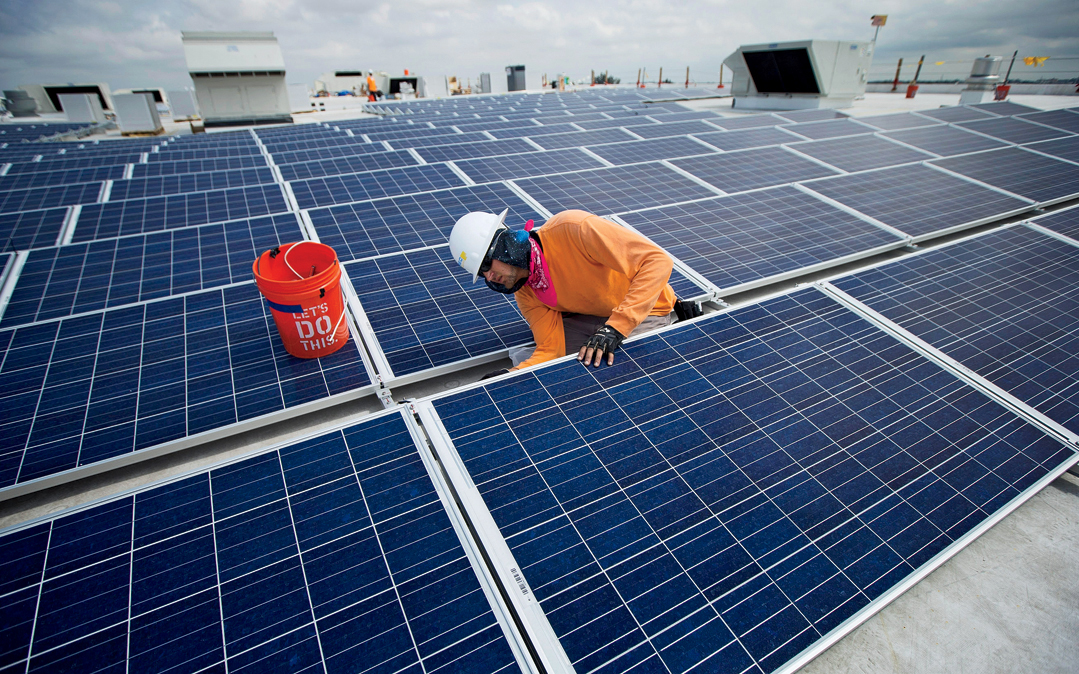
Ikea solar panels: Neil Black works on the installation of South Florida's largest solar panel array atop the future IKEA store in Miami, Wednesday, April 16, 2014. This is Ikea's 40th solar powered project in the U.S. The 178,000 square foot solar array consists of 4,620 panels. | Photo by AP Photo/J Pat Carter
Intel: Green Even Where There's No Clean Energy
Intel, one of the world's biggest tech companies, has topped the EPA's 100% Green Power Users list since 2008. The company buys credits equal to all its electricity from renewable sources. Last year, it purchased twice as much renewable energy as the number-two company on the list, Kohl's.
Intel, which operates semiconductor fabrication plants (known as fabs) in Arizona, New Mexico, and Oregon (as well as in China, Ireland, and Israel), is a heavy user of energy, requiring about 3.1 billion kilowatt-hours worldwide per year--as much as is used by 290,000 American homes.
"Even if we covered every inch of every one of our properties with solar, it would add up to a single-digit percentage of our usage," says Marty Sedler, Intel's director of global utilities and infrastructure.
Intel's facilities are located mostly in states where the electric utility operates as a monopoly and there is little or no retail choice. The result is that Intel, like many other companies, buys the vast majority of its renewable energy via renewable energy certificates, or RECs (see main story). It buys only RECs that are certified by a third party, to assure their integrity. "We get geothermal, we get wind, hydro, low-impact hydro, and we know how every kilowatt-hour is produced," Sedler says.
But RECs have drawbacks. Most are relatively cheap: $1 or so per megawatt-hour, according to the Department of Energy--not enough to change the economics of renewables. (Prices have fallen as more companies have built their own projects.) And while they are low-cost, they are always a cost--unlike direct investments in wind or solar projects, which could, depending on future electricity prices, turn out to be profitable. So it's hard to make a dollars-and-cents argument on behalf of RECs, which mostly deliver public relations value.
To its credit, Intel has recently increased its direct investments in renewables. "We're constantly looking at raising the bar," Sedler says. The company has 21 solar projects at 10 facilities in the United States, as well as in Costa Rica, India, Israel, and Vietnam, with a total capacity of 9 megawatts. It's also looking at larger, off-site projects. "Our whole intention is to grow the industry," Sedler says. "We need to get the costs of renewables down."
Mars: Taking the Long View
Kevin Rabinovitch, the global sustainability director at confectionery giant Mars, was charged with driving down his company's energy use and greenhouse gas emissions. But he was uncomfortable with relying on renewable energy credits.
"We didn't feel it was a credible solution," he says. In setting an alternative strategy, Rabinovitch and his colleagues had an advantage over public companies. Mars is a family-owned firm, albeit a very large one, so it doesn't have to answer to investors who worry about quarterly earnings. The company can take a longer view, guided by a principle it calls "mutuality," meaning that its actions should create benefits not just for Mars but also for its workers, customers, suppliers, and community.
Dealing with climate change fell squarely into that long view, particularly for a company so closely identified with chocolate. More than half the world's cacao is cultivated in West Africa, but by 2060 much of the region could be too hot to grow the crop, according to the International Center for Tropical Agriculture and the World Cocoa Foundation. Even so, Mars didn't want to get into financing renewable energy projects. "We're a food company," Rabinovitch says. "For us, it doesn't make sense to own large-scale energy assets."
The company was willing to take a calculated risk, however, by betting that, in the long term, the cost of wind energy will be no higher and perhaps even lower than that of electricity bought from the grid. Last year Mars invited developers of renewable energy projects to submit proposals for delivering 800,000 megawatt-hours of green energy per year over the next 20 years, enough to power about 61,000 homes. Within a few weeks, the company got 39 proposals from 13 developers. It eventually signed a 20-year agreement to buy wind energy at a fixed price from Sumitomo, a Japanese firm. Because Sumitomo was guaranteed a solid, long-term cash flow, it was able to borrow money to build a wind farm in West Texas at a lower rate, improving the project's economics. The 200-megawatt wind farm will generate 100 percent of the electricity needed by Mars's U.S. operations, which include 37 factories as well as offices--although, of course, the power from the particular project will flow into the grid.
Mars is also developing on-site power generation, including a 2-megawatt solar array on the New Jersey factory where M&Ms are produced, which will provide 20 percent of its energy. Such projects, Rabinovitch says, "are great for demonstrating visible leadership. They're great for engagement and reputation with the local community. The one thing that, unfortunately, they don't do is put a big dent in our numbers." To that end Mars is working on a large renewable energy project in China and is exploring opportunities in Mexico and the United Kingdom, where it also has operations.
IKEA: "We Intend to Be Around"
No company outside the energy industry has committed as much capital to renewable power as IKEA, with its allocation of $1.9 billion.
"We want to show that mainstream businesses have a high level of ambition around renewables," says Steve Howard, IKEA's chief sustainability officer.
Like Mars, IKEA has the advantage of being privately held, with no need to explain itself to short-term-oriented investors. "As long as people need a sofa to sit on or a table to eat on, we intend to be around," Howard says.
More to the point, the company believes that its investments in wind, solar, and geothermal energy will pay off in time. "There is a high likelihood that [fossil] energy prices will go up," Howard says. "Carbon can and should be priced."
IKEA's biggest single project is a 98-megawatt wind farm now under construction in Hoopeston, Illinois. It is expected to generate the equivalent of 130 percent of the total energy (electricity and heat) consumed by IKEA's 40 stores, five distribution centers, and one factory in the United States.
The financial logic behind the investment goes like this: If, as the company expects, electricity prices rise, IKEA will make money from the wind farm. If electricity prices drop, the wind farm won't be as profitable, but the company will benefit from falling prices as it buys electricity elsewhere on the grid.
IKEA is the fifth-largest commercial user of solar in the United States, behind Walmart. It has built solar installations on 90 percent of its locations in 20 states, which add up to 38 megawatts of installed capacity. IKEA stores in Centennial, Colorado, and Kansas City, Missouri, use geothermal energy.
"If every organization decided to do this, then we'd have a dramatic acceleration in renewables," says Howard. "Conventional energy is madness in today's world."
 The Magazine of The Sierra Club
The Magazine of The Sierra Club
